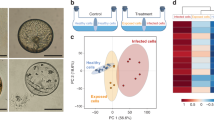Summary
In the presence of cytochalasin D, dinoflagellates undergo mitosis and the cells begin to divide, but the completion of cell division is inhibited. InPausenella (dinospore formation),Gymnodinium andProrocentrum, Siamese twins arise which remain connected at the epicones whereas the hypocones, containing the nuclei, are separated. InScripsiella where the nucleus is centrally located, irregular binucleate cell bodies result. Cyst divisions which give rise to secondary or tertiary cysts inPaulsenella are not affected. In the athecatesPaulsenella andGymnodinium the morphogenesis of the separated cell portions is not or nearly not, respectively, disturbed by cytochalasin D. In the thecatesScripsiella andProrocentrum morphogenesis is heavily affected. InProrocentrum, wrinkled theca material is deposited instead of complete valvae. Doubling of the flagellar apparatus is not inhibited. It is concluded that the first phase of cytokinesis does not depend on actin. The daughter cells begin to separate by a mechanism which seems to be associated with the mitotic apparatus. Actin, however, is involved in the further constriction of the cleavage furrow in the second phase of cytokinesis and in the morphogenesis of the theca.
Similar content being viewed by others
References
Adams AEM, Pringle JR (1981) Relationship of actin and tubulin distribution to bud growth in wild-type and morphogeneticmutantSaccharomyces cerevisiae. J Cell Biol 98: 934–945
Aubin JE, Osborn M, Weber K (1981) Inhibition of cytokinesis and altered contractile ring morphology induced by cytochalasins in synchronized PtK2 cells. Exp Cell Res 136: 63–79
Drebes G, Schnepf E (1982) Phagotrophy and development ofPaulsenella cf.chaetoceratis (Dinophyta), an ectoparasite of the diatomStrepthotheca thamesis. Helgol Meeresuntersuch 35: 501–515
Dürr G (1979 a) Elektronenmikroskopische Untersuchungen am Panzer von Dinoflagellaten. I.Gonyaulax polyedra. Arch Protistenk 122: 55–87
— (1979 b) Elektronenmikroskopische Untersuchungen am Panzer von Dinoflagellaten. II.Peridinium cinctum. Arch Protistenk 122: 88–120
Fritz L, Triemer RE (1985) A rapid simple technique utilizing Calcofluor White M2R for the visualization of dinoflagellate thecal plates. J Phycol 21: 662–664
Loeblich AR, Sherley JL, Schmidt RJ (1979) The correct position of flagellar insertion inProrocentrum and description ofProrocentrum rhathymum sp. nov. (Pyrrhophyta). J Plankton Res 1: 113–120
Menzel D (1986) Visualization of cytoskeletal changes through the life cycle inAcetabularia. Protoplasma 134: 30–42
McLachlan J (1973) Growth media-marine. In:Stein JR (ed) Handbook of phycological methods, culture methods and growth measurements. Cambridge Univ Press, Cambridge, pp 25–51
Goddette DW, Frieden C (1986) Actin polymerization. The mechanism of action of cytochalasin D. J Biol Chem 261: 15974–15980
Morill LC, Loeblich II AR (1981) The dinoflagellate pellicular wall layer and its occurrence in the division Pyrrhophyta. J Phycol 17: 315–323
— — (1984) Cell division and reformation of the amphiesma in the pelliculate dinoflagellate,Heterocapsa niei. J mar biol Ass UK 64: 939–953
Pickett-Heaps JD, McDonald KL, Tippit DH (1975) Cell division in the pennate diatomDiatoma vulgare. Protoplasma 86: 205–242
Schnepf E, Deichgräber G, Drebes G (1985) Food uptake and the fine structure of the dinophytePaulsenella sp., an ectoparasite of marine diatoms. Protoplasma 124: 188–204
Soranno T, Pickett-Heaps J (1982) Directionally controlled spindle disassembly after mitosis in the diatomPinnularia. Eur J Cell Biol 26: 234–243
Tippit DH, Pickett-Heaps JD (1976) Apparent amitosis in the binucleate dinoflagellatePeridinium balticum. J Cell Sci 21: 273–289
Triemer RE (1982) A unique mitotic variation in the marine dinoflagellateOxyrrhis marina (Pyrrophyta). J Phycol 18: 399–411
Tucker JB (1971) Microtubules and a contractile ring of microfilaments associated with a cleavage furrow. J Cell Sci 8: 557–571
Wessels NK, Spooner BS, Ash JF, Bradey MO, Luduena MA, Taylor EL, Wrenn JT, Yamada KM (1971) Microfilaments in cellular and developmental processes: Contractile microfilament machinery of many cell types is reversibly inhibited by cytochalasin B. Science 171: 135–143
Whetherbee R (1975 a) The fine structure ofCeratium tripos, a marine armored dinoflagellate. I. The cell covering (theca). J Ultrastruct Res 50: 58–64
— (1975 b) The fine structure ofCeratium tripos, a marine armored dinoflagellate. II. Cytokinesis and development of the characteristic cell shape. J Ultrastruct Res 50: 65–76
— (1975 c) The fine structure ofCeratium tripos, a marine armored dinoflagellate. III. Thecal plate formation. J Ultrastruct Res 50: 77–87
Author information
Authors and Affiliations
Rights and permissions
About this article
Cite this article
Schnepf, E. Cytochalasin D inhibits completion of cytokinesis and affects theca formation in dinoflagellates. Protoplasma 143, 22–28 (1988). https://doi.org/10.1007/BF01282955
Received:
Accepted:
Issue Date:
DOI: https://doi.org/10.1007/BF01282955




